Celebrating Lupin III’s 40th with The Owl in the Rafters
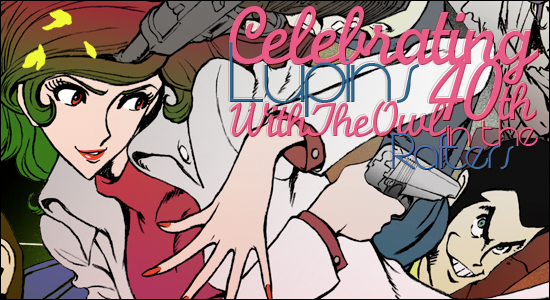
![[Lupin III A Woman Named MINE Fujiko] Promo small clean](http://918thefan.com/wp-content/uploads/2012/03/Lupin-III-A-Woman-Named-MINE-Fujiko-Promo-small-clean-210x300.jpg)
So, last time we took a little crash course in Yoshihiko Umakoshi’s roles as animation director and character designer in order to prep for the recent Saint Seiya Omega. This week I’ve got another hot reboot to cover and another talented animator to touch on: Lupin III – Mine Fujiko to Iu Onna (lit. “The Woman Called Fujiko Mine“), featuring character designs and animation direction by Takeshi Koike, director of the film Redline.
Today, April 4th, 2012 (that’s 04/04, if you hadn’t noticed) is being celebrated as the 40th anniversary of the end of the original Lupin III (alternatively written as Lupin the Third and sometimes Lupin the 3rd) manga which began publishing in Futabasha’s Weekly Manga Action magazine in 1967 where it ran until 1972. Weekly Manga Action is a popular seinen magazine that began publishing in 1967, with Lupin III as one of their flagship titles, and is considered the original true seinen manga magazine.  For those unfamiliar with the terms, shonen and shoujo refer to young male and young female target demographics, respectively. Seinen and Josei refer to an older male and female audience, respectively. (“Young” here refers to the age range of around 10-15 and “older” is generally 18+)
For those unfamiliar with the terms, shonen and shoujo refer to young male and young female target demographics, respectively. Seinen and Josei refer to an older male and female audience, respectively. (“Young” here refers to the age range of around 10-15 and “older” is generally 18+)
Weekly Manga Action is of course still running to this day and in the past has featured some of the premier seinen manga titles, including: Kazuo Koike’s Lone Wolf and Cub, Yoshito Usui’s Crayon Shin-chan, Shotaro Ishinomori’s 009-1, and Garon Tsuchiya’s Old Boy, the same manga on which the internationally acclaimed 2003 Korean film of the same name was based.
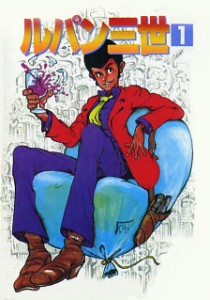 Following the end of Lupin III‘s original publication there was also the sequel manga Lupin III – The World’s Most Wanted that ran in Weekly Manga Action from 1977 to 1981, three different anime series that aired between 1971 and 1985 that comprise what is considered the original anime, as well as thirty-six different feature films, OVAs, and television specials including the classic 1979 Castle of Cagliostro film (famously written and directed by Hayao Miyazaki prior to the founding of Studio Ghibli) and the Lupin III vs Detective Conan cross over special. The various anime and films have also proven fairly successful overseas albeit under a variety of name changes in Europe due to copyright issues during the 60s and 70s. Within Japan Lupin III remains within the top 50 manga series regarded by Japan’s Agency for Cultural Affairs branch of the Ministry of Education, and has regularly received praise from a wide range of other polls and surveys.
Following the end of Lupin III‘s original publication there was also the sequel manga Lupin III – The World’s Most Wanted that ran in Weekly Manga Action from 1977 to 1981, three different anime series that aired between 1971 and 1985 that comprise what is considered the original anime, as well as thirty-six different feature films, OVAs, and television specials including the classic 1979 Castle of Cagliostro film (famously written and directed by Hayao Miyazaki prior to the founding of Studio Ghibli) and the Lupin III vs Detective Conan cross over special. The various anime and films have also proven fairly successful overseas albeit under a variety of name changes in Europe due to copyright issues during the 60s and 70s. Within Japan Lupin III remains within the top 50 manga series regarded by Japan’s Agency for Cultural Affairs branch of the Ministry of Education, and has regularly received praise from a wide range of other polls and surveys.
 There was also a Lupin VIII series planned during the 80s, primarily funded by a French company intent on cashing in on the original anime’s success, it planned to feature the decedents of all the main cast reprising all the same roles but in a space faring sci-fi setting. The project was of course ultimately scrapped but for those hardcore fans interested in digging up those rare little nuggets of geeky gold however, there is a bootleg VHS rip of the incomplete pilot episode still floating around the internet, complete with soundtrack and sound effects edited in but without any recorded dialogue.
There was also a Lupin VIII series planned during the 80s, primarily funded by a French company intent on cashing in on the original anime’s success, it planned to feature the decedents of all the main cast reprising all the same roles but in a space faring sci-fi setting. The project was of course ultimately scrapped but for those hardcore fans interested in digging up those rare little nuggets of geeky gold however, there is a bootleg VHS rip of the incomplete pilot episode still floating around the internet, complete with soundtrack and sound effects edited in but without any recorded dialogue.
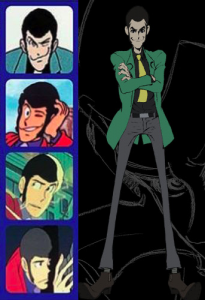 If you are reading this and have somehow managed to either never heard of Lupin III before now, or know the name but just haven’t seen it, I’ll try to lay out the basic premise as simply as possible. The titular character, Arsene Lupin III, is an unparalleled thief and master of disguise capable of stealing anything from anyone and renowned internationally for announcing his capers publicly or directly to police before every heist, and of course accomplishing each one without fail. He is also a laid back and carefree goofball as well as a ladies’ man and an implied playboy -although more often than not he’s only shown getting turned down or fleeing the scene before he can really do much more than flirt around.
If you are reading this and have somehow managed to either never heard of Lupin III before now, or know the name but just haven’t seen it, I’ll try to lay out the basic premise as simply as possible. The titular character, Arsene Lupin III, is an unparalleled thief and master of disguise capable of stealing anything from anyone and renowned internationally for announcing his capers publicly or directly to police before every heist, and of course accomplishing each one without fail. He is also a laid back and carefree goofball as well as a ladies’ man and an implied playboy -although more often than not he’s only shown getting turned down or fleeing the scene before he can really do much more than flirt around.
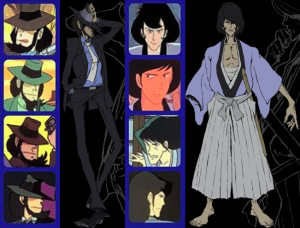 Assisting him in his various crimes are his two friends and accomplices: Daisuke Jigen, a marksman with unmatched skills in both quickdraw and sharshooting as well as an all around firearms specialist, although the extent of his skills fluctuates between reasonably superhuman to outright absurd depending on the writer, and Ishikawa Goemon XIII, a master swordsman descended from a long line of samurai and inheritor of a legendary and neigh unbreakable katana that can cut through nearly anything; like Jigen’s marksmanship, the application of Goemon’s potentially absurd skills can range from modest to ridiculous depending on the story’s writer. Goemon is also a much more reluctant part time accomplice to Lupin’s crimes, while Jigen is more of a full time sidekick. Both tend to play straightman to Lupin’s comedic antics.
Assisting him in his various crimes are his two friends and accomplices: Daisuke Jigen, a marksman with unmatched skills in both quickdraw and sharshooting as well as an all around firearms specialist, although the extent of his skills fluctuates between reasonably superhuman to outright absurd depending on the writer, and Ishikawa Goemon XIII, a master swordsman descended from a long line of samurai and inheritor of a legendary and neigh unbreakable katana that can cut through nearly anything; like Jigen’s marksmanship, the application of Goemon’s potentially absurd skills can range from modest to ridiculous depending on the story’s writer. Goemon is also a much more reluctant part time accomplice to Lupin’s crimes, while Jigen is more of a full time sidekick. Both tend to play straightman to Lupin’s comedic antics.
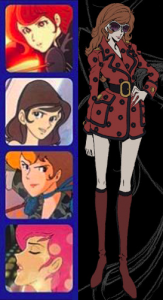 Of course the fourth key accomplice is Fujiko Mine, central character in the new series. An on and off lover of Lupin’s and an accomplished thief and con artist herself, she crosses paths with Lupin quite often, mostly in collaboration, either intentional or accidental, but on some occasion in opposition when the two are both after the same treasure. She is also very reluctant to cooperate with Lupin in most cases, both because of his unpredictable and troublesome nature as a thief and for his meddlesome romantic habits. Lupin is head over heels for Fujiko and will often take irrational risks both to his heist and to himself in order to help her, something his partners often object to, but nonetheless cooperate with for his sake. Initially the character was written as a temptress for all three men of Lupin’s gang, but as the characters grew to be more properly developed over time, Jigen was written to outright dislike Fujiko, regularly complaining about her getting involved on the assumption that she’ll try to swindle the boys out of their loot for the episode (which she often does). Goemon was made out to be romantically and sexually indifferent, playing up the strict and stoic samurai image, something Fujiko occasionally teases him about, but that Goemon manages to (mostly) ignore.
Of course the fourth key accomplice is Fujiko Mine, central character in the new series. An on and off lover of Lupin’s and an accomplished thief and con artist herself, she crosses paths with Lupin quite often, mostly in collaboration, either intentional or accidental, but on some occasion in opposition when the two are both after the same treasure. She is also very reluctant to cooperate with Lupin in most cases, both because of his unpredictable and troublesome nature as a thief and for his meddlesome romantic habits. Lupin is head over heels for Fujiko and will often take irrational risks both to his heist and to himself in order to help her, something his partners often object to, but nonetheless cooperate with for his sake. Initially the character was written as a temptress for all three men of Lupin’s gang, but as the characters grew to be more properly developed over time, Jigen was written to outright dislike Fujiko, regularly complaining about her getting involved on the assumption that she’ll try to swindle the boys out of their loot for the episode (which she often does). Goemon was made out to be romantically and sexually indifferent, playing up the strict and stoic samurai image, something Fujiko occasionally teases him about, but that Goemon manages to (mostly) ignore.
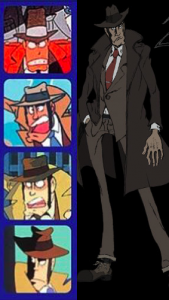 Of course, I can’t move on without mentioned Inspector Koichi Zenigata, Lupin III’s primary antagonist, I say antagonist because calling him a “rival” might be a bit of a stretch. Zenigata is a Japanese officer of Interpol with the uncanny ability to keep up with most of Lupin’s outrageous crimes, but of course without ever truly succeeding in stopping Lupin. While no super man, like Goemon and Jigen tend to be, Zenigata has shown off skills in karate and judo as well as general fitness, shown in his ability to chase Lupin across all manner of obstacles, and his own unique talent for masterfully wielding handcuffs as non-lethal weapons. While mostly a comedic character who only blunders in trying to stop Lupin time after time, his ability to tell where Lupin is or will be do actually make him the only police office with even the slightest chances of catching Lupin for good.
Of course, I can’t move on without mentioned Inspector Koichi Zenigata, Lupin III’s primary antagonist, I say antagonist because calling him a “rival” might be a bit of a stretch. Zenigata is a Japanese officer of Interpol with the uncanny ability to keep up with most of Lupin’s outrageous crimes, but of course without ever truly succeeding in stopping Lupin. While no super man, like Goemon and Jigen tend to be, Zenigata has shown off skills in karate and judo as well as general fitness, shown in his ability to chase Lupin across all manner of obstacles, and his own unique talent for masterfully wielding handcuffs as non-lethal weapons. While mostly a comedic character who only blunders in trying to stop Lupin time after time, his ability to tell where Lupin is or will be do actually make him the only police office with even the slightest chances of catching Lupin for good.
 As something of a historical aside, both Goemon XIII and Lupin III are direct decedents of famous fictional characters. The original Ishikawa Goemon was actually a real figure in Japanese history, although his legacy lives on almost entirely through wildly exaggerated and overly stylized fictional accounts of his life via folk lore and pop culture. His most famous incarnation painted him as a Robin Hood-like character: a thief robbing from the clan of Oda Nobunaga and giving the spoils to the poor. Other accounts claim he was born to a family of samurai before turning to anti-athoritarian banditry, and others still claim he was trained as a ninja and abandoned his secret society to assassinate various tyrannical warlords of his time. In any account he is portrayed as an honorable outlaw and a peerless warrior, both traits that Lupin III’s Goemon XIII inherits.
As something of a historical aside, both Goemon XIII and Lupin III are direct decedents of famous fictional characters. The original Ishikawa Goemon was actually a real figure in Japanese history, although his legacy lives on almost entirely through wildly exaggerated and overly stylized fictional accounts of his life via folk lore and pop culture. His most famous incarnation painted him as a Robin Hood-like character: a thief robbing from the clan of Oda Nobunaga and giving the spoils to the poor. Other accounts claim he was born to a family of samurai before turning to anti-athoritarian banditry, and others still claim he was trained as a ninja and abandoned his secret society to assassinate various tyrannical warlords of his time. In any account he is portrayed as an honorable outlaw and a peerless warrior, both traits that Lupin III’s Goemon XIII inherits.
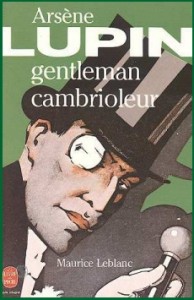 Lupin himself is of course the decedent of the original Arsene Lupin, a character from Maurice Leblanc’s world famous detective fiction novels published in the early 1900s. While not quite as internationally famous as Sherlock Holmes, Arsene Lupin is considered a comparably iconic figure in detective fiction and is treated with similar timelessness in France and various French influenced countries, appearing in various films, TV series, theater shows, comic books, and cartoons. The character even appeared on an official French postage stamp in 1996 as part of a collection of famous French police and criminal characters.
Lupin himself is of course the decedent of the original Arsene Lupin, a character from Maurice Leblanc’s world famous detective fiction novels published in the early 1900s. While not quite as internationally famous as Sherlock Holmes, Arsene Lupin is considered a comparably iconic figure in detective fiction and is treated with similar timelessness in France and various French influenced countries, appearing in various films, TV series, theater shows, comic books, and cartoons. The character even appeared on an official French postage stamp in 1996 as part of a collection of famous French police and criminal characters.
There was even an unofficial cross over novel, Arsene Lupin vs. Herlock Sholmes, named as such to avoid complications with Sherlock Holmes author, Conan Doyle, but none the less written and published under the name of Maurice Leblanc. The Herlock Sholmes character makes multiple reappearances later in Leblanc’s publications; these cross overs were likely the inspiration of the Lupin III vs Detective Conan TV special. The original Lupin was also the basic influence behind Kaito Kid, one of the more prominent reoccurring villains of Detective Conan and star of his own short manga by the same author, Gosho Aoyama.
While not at all as goofy as his anime/manga counterpart, the original Lupin was in fact a gentleman thief and master of disguise of unmatched talents and known to announce his crimes before hand as a challenge to anyone who might try to stop him. In spite of his criminal persona, the original Lupin, and Lupin III, both share the need to rob from people more villainous than themselves, often exacting a kind of justice against corrupt wealth, while profiting themselves by convenience.
 In the Lupin III franchise’s history the many films and television series have made use of the talents of over a dozen talented directors, including a personal favorite: Hideo Takayashiki, screenplay and script writer for shows like Ashita no Joe, Osamu Tezuka’s Astro Boy and Phoenix, Rumiko Takahashi’s Maison Ikkoku series and One Pound Gospel OVA, Master Keaton, Kaiji seasons 1 and 2, Rainbow, and One Outs just to name a few of the better known.
In the Lupin III franchise’s history the many films and television series have made use of the talents of over a dozen talented directors, including a personal favorite: Hideo Takayashiki, screenplay and script writer for shows like Ashita no Joe, Osamu Tezuka’s Astro Boy and Phoenix, Rumiko Takahashi’s Maison Ikkoku series and One Pound Gospel OVA, Master Keaton, Kaiji seasons 1 and 2, Rainbow, and One Outs just to name a few of the better known.
I won’t be going over the entire list, let alone the achievements therein, but among the many directors of Lupin III are of course both Hayao Miyazaki and Isao Takahata, the two key directors and founding members of Studio Ghibli, and the late Noboru Ishiguro, director of some of the most defining sci-fi series of the 80s and 90s both in Japan and America, including Space Battleship Yamato (Star Blazers in English speaking countries), Megazone 23, the original Super Dimension Fortress Macross, as well as Super Dimension Century Orguss which would go on to spawn the sequel Super Dimension Cavalry Southern Cross, (Southern Cross and the original Macross comprise two of the three series used to make the American hit series, Robotech) and the legendarily long 110 episode OVA, Legend of the Galactic Heroes. The third television series even saw direction from an actual film director and actor, Seijun Suzuki, the famed (or perhaps more notorious) surrealist/absurdist Japanese film director of the 1960s and 70s.
director of some of the most defining sci-fi series of the 80s and 90s both in Japan and America, including Space Battleship Yamato (Star Blazers in English speaking countries), Megazone 23, the original Super Dimension Fortress Macross, as well as Super Dimension Century Orguss which would go on to spawn the sequel Super Dimension Cavalry Southern Cross, (Southern Cross and the original Macross comprise two of the three series used to make the American hit series, Robotech) and the legendarily long 110 episode OVA, Legend of the Galactic Heroes. The third television series even saw direction from an actual film director and actor, Seijun Suzuki, the famed (or perhaps more notorious) surrealist/absurdist Japanese film director of the 1960s and 70s.
Adding to this list of directors with the new The Woman Called Fujiko Mine series this season is Sayo Yamamoto, who previously worked on shows like Death Note, Eureka Seven, the Evangelion 2.0 movie, Gunslinger Girl, High School of the Dead, Kemonozume, and Abenobashi Magical Shopping Arcade, as story board artist, with some experience directing on episodes of Samurai Champloo, Panty & Stocking, and Texhnolyze, Ergo Proxy, and most notably as a key assistant under Takeshi Koike on his internationally toured film Redline and its pilot series, Trava: Fist Planet. Technically The Woman Called Fujiko Mine will be the first full chief director role Ms.Yamamoto has had and I look forward to seeing how she approaches the project.
High School of the Dead, Kemonozume, and Abenobashi Magical Shopping Arcade, as story board artist, with some experience directing on episodes of Samurai Champloo, Panty & Stocking, and Texhnolyze, Ergo Proxy, and most notably as a key assistant under Takeshi Koike on his internationally toured film Redline and its pilot series, Trava: Fist Planet. Technically The Woman Called Fujiko Mine will be the first full chief director role Ms.Yamamoto has had and I look forward to seeing how she approaches the project.
 I mentioned in the opening of this article, Takeshi Koike, the director and original creator of Redline and Trava working on this new Lupin III series. If you missed out on Redline and the hype surrounding it as the first classically hand painted anime in decades, let me go over Koike’s professional history just a bit to add some context.
I mentioned in the opening of this article, Takeshi Koike, the director and original creator of Redline and Trava working on this new Lupin III series. If you missed out on Redline and the hype surrounding it as the first classically hand painted anime in decades, let me go over Koike’s professional history just a bit to add some context.
Koike is often looked upon as a kind of prodigy in animation. His career with studio Madhouse began immediately following his high school graduation, where he worked under famous anime director/writer, Yoshiaki Kawajiri: best known as the director of anime films and OVAs like Wicked City, Ninja Scroll both the film and TV series, A Wind Named Amnesia, Vampire Hunter D: Bloodlust, Demon City Shinjuku, the original Birdy the Mighty, CLAMP’s X film and X/1999 TV series. Since the late 80s Koike has worked as a key animator and animation director on close to four dozen different animated TV series, OVAs, and films, including all of Kawajiri’s projects, as well as several animated segments of live action films, including Katsuhito Ishii’s award winning film, The Taste of Tea, and the infamously bizarre Funky Forest: The First Contact by the same director. Katsuhito Ishii also helped to co-direct Koike’s mini series, TRAVA: Fist Planet which follows two minor characters from Redline, the titular Trava and his friend/co-worker/mechanic, Shinkai.
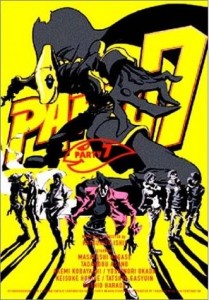 Koike’s first big role as director was actually for a tiny five and a half minute long opening sequence to Katsuhito Ishii’s 2000 film, Party 7. I won’t really vouch for Ishii’s talent as a director (I am not exactly a fan of his work) but if you happen on the chance to watch the film, or at least the first 6 minutes of it, I would highly recommend you do so just for a glimpse of Koike’s early work. Koike was also the character designer and over all director of the pilot episodes for both the Afro Samurai TV series in 2003, and the more recent Iron Man anime in 2009, as well as the World Record short in the Animatrix short film collection released in 2003. Both World Record and the pilot of Afro Samurai, Koike displays his unique sense of motion and action in a way that fully utilizes the animated medium to perform impossible camera tricks and perspectives that actually complement the sense of motion, instead of feeling totally arbitrary, as many experimental film and animation techniques tend to.
Koike’s first big role as director was actually for a tiny five and a half minute long opening sequence to Katsuhito Ishii’s 2000 film, Party 7. I won’t really vouch for Ishii’s talent as a director (I am not exactly a fan of his work) but if you happen on the chance to watch the film, or at least the first 6 minutes of it, I would highly recommend you do so just for a glimpse of Koike’s early work. Koike was also the character designer and over all director of the pilot episodes for both the Afro Samurai TV series in 2003, and the more recent Iron Man anime in 2009, as well as the World Record short in the Animatrix short film collection released in 2003. Both World Record and the pilot of Afro Samurai, Koike displays his unique sense of motion and action in a way that fully utilizes the animated medium to perform impossible camera tricks and perspectives that actually complement the sense of motion, instead of feeling totally arbitrary, as many experimental film and animation techniques tend to.
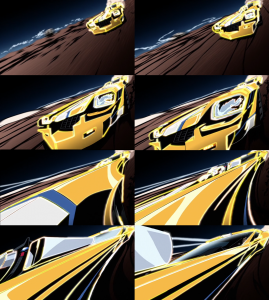 Koike’s art and animation make use of high contrast light and shadow, sharp, bold line work, and high saturated colors to give off a very strong and vibrant pop to everything. His use of exaggerated perspective and dynamic camera angles as well as an occasional dip into a very trippy kind of surrealism, usually invoked by extreme speed, makes for a unique blend of sleek modern action and the kind of experimental psychedelic art that was more popular during the 60s and 70s than it is today. I really wish there was a way to get this across without just sitting you down to watch clips of the film but no still images really capture that sense of motion unique to Koike’s art style; I think is a good sign, though, because it shows that he really is making the best use of his medium to create a truly unique entertainment experience.
Koike’s art and animation make use of high contrast light and shadow, sharp, bold line work, and high saturated colors to give off a very strong and vibrant pop to everything. His use of exaggerated perspective and dynamic camera angles as well as an occasional dip into a very trippy kind of surrealism, usually invoked by extreme speed, makes for a unique blend of sleek modern action and the kind of experimental psychedelic art that was more popular during the 60s and 70s than it is today. I really wish there was a way to get this across without just sitting you down to watch clips of the film but no still images really capture that sense of motion unique to Koike’s art style; I think is a good sign, though, because it shows that he really is making the best use of his medium to create a truly unique entertainment experience.
 Koike’s sense of high octane action coupled with his love of cars and of course his familiarity with the anime industry make for a stellar combination that ought to bring the car chases and gun fights of the new Lupin III a real marvel. I should also mention that Koike has a very distinct brand of sexy that will undoubtably manifest itself in Fujiko’s character and her central role in the new series: wide hips, full lips, long legs, a whole lot of curves, and a cool, laid back attitude that defies the more common spiteful faux-independence and outdated fair maiden images. If ever there was someone who could be counted on to update the classic Lupin III into something that can really draw in a new, young audience while still upholding the integrity of the original character designs, I honestly believe that Koike may be the absolute best choice possible in the current market.
Koike’s sense of high octane action coupled with his love of cars and of course his familiarity with the anime industry make for a stellar combination that ought to bring the car chases and gun fights of the new Lupin III a real marvel. I should also mention that Koike has a very distinct brand of sexy that will undoubtably manifest itself in Fujiko’s character and her central role in the new series: wide hips, full lips, long legs, a whole lot of curves, and a cool, laid back attitude that defies the more common spiteful faux-independence and outdated fair maiden images. If ever there was someone who could be counted on to update the classic Lupin III into something that can really draw in a new, young audience while still upholding the integrity of the original character designs, I honestly believe that Koike may be the absolute best choice possible in the current market.
Other notable staff members include Dai Sato, the script writer, who previously wrote for various episodes of Cowboy Bebop, Eureka Seven, Ergo Proxy, Eden of the East, Ghost in the Shell: Stand Alone Complex, Samurai Champloo, Wolf’s Rain and the Halo Legends OVA as script and screenplay writer. Also, stepping up to the plate as key musician -and presumably from that title, composer- for The Woman Called Fujiko Mine‘s soundtrack is Naruoshi Kikuchi, the saxophone player in the progressive Jazz band, Tipographica which he formed with Akira Minakmai (keyboard)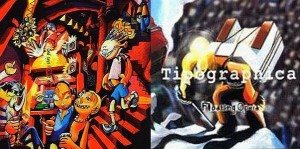 and Tsuneo Imahori (guitarist and composer) in the 1980s. Tsuneo Imahori is well known in the anime industry for his composition and performance of the soundtracks to the Gungrave franchise, both games and animated TV series, as well as the original Trigun soundtrack, which Kikuchi performed for.
and Tsuneo Imahori (guitarist and composer) in the 1980s. Tsuneo Imahori is well known in the anime industry for his composition and performance of the soundtracks to the Gungrave franchise, both games and animated TV series, as well as the original Trigun soundtrack, which Kikuchi performed for.
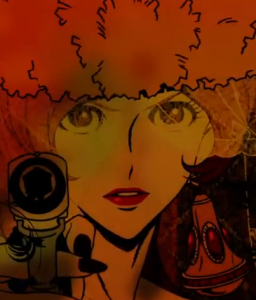 Given Koike’s fast paced and often absurd style of sharp and sexy action and Lupin III‘s usual propensity for wild, crazy antics and classically pulpy sex appeal, I expect a genuinely heart-pounding, hot blooded, kind of action that will keep us on the edge of our seats; Dai Sato’s writing ought to ensure an interesting take on Lupin III’s usual zany capers; and Kikuchi’s jazz ensemble ought to breathe some real life and personality into Lupin III’s chaotic and often sexy globe-trotting hijinks. I think it is safe to say that this new series will certainly be an very drastic change of pace for the look and feel of the Lupin III franchise, but with such a promising collection of talent behind it, it is one that I believe will produce an enjoyable and much needed revival to the Lupin III name.
Given Koike’s fast paced and often absurd style of sharp and sexy action and Lupin III‘s usual propensity for wild, crazy antics and classically pulpy sex appeal, I expect a genuinely heart-pounding, hot blooded, kind of action that will keep us on the edge of our seats; Dai Sato’s writing ought to ensure an interesting take on Lupin III’s usual zany capers; and Kikuchi’s jazz ensemble ought to breathe some real life and personality into Lupin III’s chaotic and often sexy globe-trotting hijinks. I think it is safe to say that this new series will certainly be an very drastic change of pace for the look and feel of the Lupin III franchise, but with such a promising collection of talent behind it, it is one that I believe will produce an enjoyable and much needed revival to the Lupin III name.



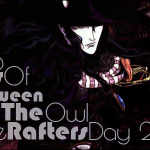











Also worth pointing out is that Funimation is symulcasting the new Lupin III series as episodes debut.
http://www.animenewsnetwork.com/news/2012-04-07/funimation-to-simulcast-new-lupin-iii-tv-anime-series
Yup, we reported it here live before anyone else. http://918thefan.com/2012/live-blog-anime-bostons-funimation-industry-panel/